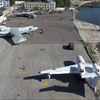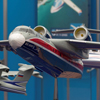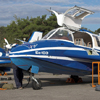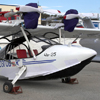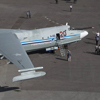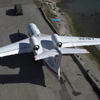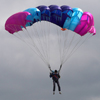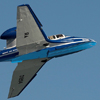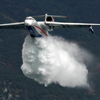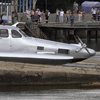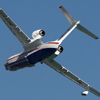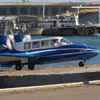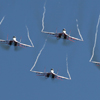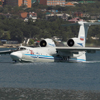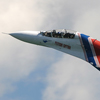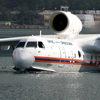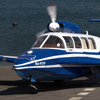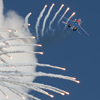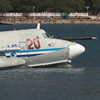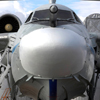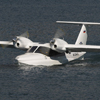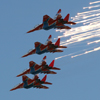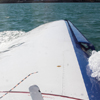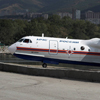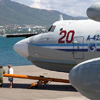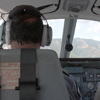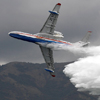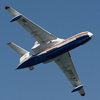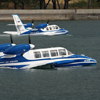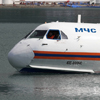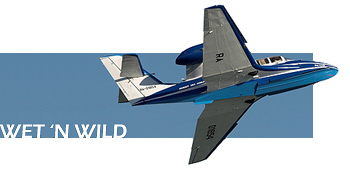
Gelendzhik's Gidroaviasalon 2006 Review
Wednesday 6th September - Sunday 10th September
Located on the Black Sea coast, in the Krosnodar region of southern Russia is the picturesque 'riviera' town of Gelendzhik. Every other year the town, and more specifically the bay in which it sits, plays host to a number of amphibious aircraft and seaplanes. The event, known as Gidroaviasalon, is essentially a trade show with the purpose of demonstrating ship and water-based aviation, its development as well as practical applications of the technology. The primary areas of focus are on passenger and cargo transportation, tourism, waterborne patrol, search and rescue operations and the ability to provide support and assistance in times of emergency and ecological disasters.
spent two days at Gelendzhik's Gidroaviasalon '06. All photography by the author.
The sixth International Exhibition and Scientific Conference on Hydroaviation was held over a five-day period early in September. As that title suggests, this was more than just an airshow, with many conferencing sessions scheduled to address all manner of topics from design of special systems and equipment for water-based flying vehicles, right through to the implications and experiences of putting them into practice.
As one would expect with any trade show, the marquee complex housed countless stands covering everything from manufacturers of individual components all the way through to the big aircraft manufacturers like Beriev who were obviously looking to sell their completed aircraft.
Of course, the exhibitions were not the reason for our attendance. The English translation for the flying participation on the website made it a "not to be missed" event. Beriev were scheduled to display the Be-12, A-42, Be-103 plus the Be-200, with other highlights set to include the Russian Knights, Swifts, a pair of Ka-27 helicopters, solo displays by MiG-29UB, Su-27K and Su-27P aircraft, a Kamov company demonstration by the Ka-32 and Ka-52, the Russian Navy providing a demonstration with Il-38 and Tu-142 dropping KAS containers, and finally a Mil Mi-14 demonstrating the ability to land and manouevre on water.
The difference between that list and what we actually got was stark to say the least. The show ran from the Wednesday through to the Sunday, with our attendance falling on the Thursday and Friday. It's not entirely clear whether anything close to the full programme actually took place over the weekend or not, but there were definitely some additional items over those two days.
Flying participation was not helped by an incident involving AeroVolga's LA-8 amphibian the day prior to our visit. Evidently one of the floats broke off whilst it was in the water and only some very skillful handling by the pilot prevented disaster from striking.
On the Thursday the show was opened by a parachute jump from a Mil Mi-17, operating from what remained of the Gelendzhik airport, a site which is currently closed whilst major construction works are undertaken. In fact, many of the items listed in the flying programme were, according to the list, scheduled to operate from here, throwing into question the legitimacy of the published programme. This element of the show was repeated on a further two occasions during the day as nothing more than padding.
Beriev then performed their company demos, although again, nothing like what was scheduled. According to a number of sources the certificate of airworthiness for the Be-12 had expired, and hence it wasn't even present at the event. The A-42 Albatros, however, was there but was suffering from a problem with one engine and this prevented it from leaving dry dock at all this day. What we did get were a series of water take-offs and landings by the Be-200, followed later on by a number of water bombing demonstrations. These definitely provided the most spectacular photographic opportunities of the day.
Interspersed between the two elements of the Be-200 display were a series of flypasts by three of the Beriev Be-103s, an aircraft that anyone and everyone could fly in later in the day for a mere 1500 Rubles (approx £30). Indeed, if it wasn't for these pleasure flights there would have almost been nothing else to photograph that day.
The only other vehicle to enter the water during the display was the Amphibious Transportation Technologies Ekranoplan, essentially a boat with wings that cruises just above the surface of the water on a cushion of high-pressured air that is created by the aerodynamic interaction between the wing and the surface, called ground effect.
A second Be-200 did fly, although not as part of the flying display. This one belonged to the Russian Ministry for Emergency Situations (MChS Rossii) and it performed an experience flight for members of the press and a number of locals.
The Friday did offer something different and the crowd were treated to a demonstration by the Russian Knights, together with the Swifts and then in addition each team performed individually. From speaking to several members of the press corps, it was suggested that this was not planned for the Friday at all, but the feedback received from Thursday's display was so scathing that the organisers felt that action had to be taken.
Once again the A-42 was unable to display, but it did at least make it into the water on this occasion, performing a number of engine runs over on the far side of the bay. The Beriev contingent this day was just a Be-200, again performing take-offs, landings and water-bombing demonstrations, and a single Be-103. That concluded the display.
Whilst there were some excellent sights to be seen at Gelendzhik's Gidroaviasalon 2006, the author was left with a real sense of what might have been. Had the flying display lived up to the billing this really could have been an event to rival anything that had gone before it, but certainly for anyone present on the two days that we were this was not the case and you really could not help but be bitterly disappointed with the action that was served up.

